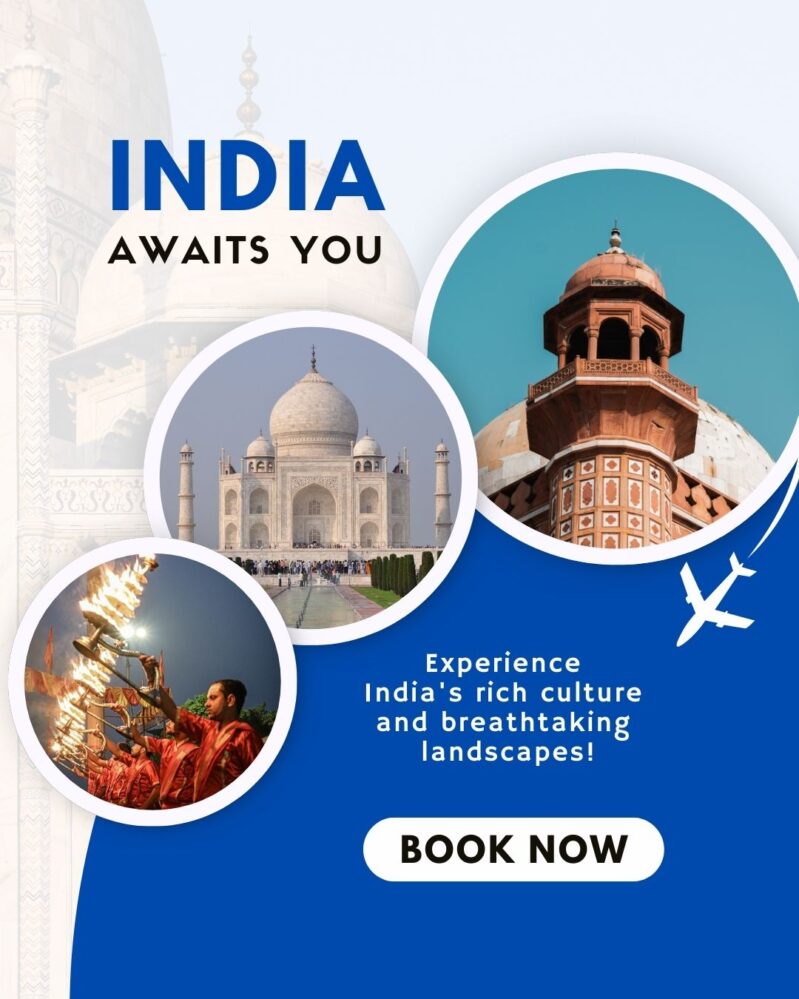
India is a land of colors, contrasts, and cultures. With over a billion people, 22 official languages, and landscapes that range from the snowy Himalayas to the sun-kissed beaches of Goa, it’s a country that offers something for everyone. Whether you’re a first-time traveler or a budget backpacker, this India travel guide covers everything you need to know for a memorable and meaningful journey.
Why Visit India?
India is not just a destination—it’s an experience. You’ll find ancient temples, bustling cities, tranquil villages, spiritual retreats, and vibrant festivals all coexisting in a beautiful mess. The food, people, traditions, and geography change every few hundred kilometers, making each region feel like a new country in itself.
For first-time visitors and backpackers, India offers both affordable travel and rich cultural exposure. Whether you’re looking to meditate in Rishikesh, party in Goa, hike in Himachal, or explore royal palaces in Rajasthan, India caters to every type of traveler.
Best Time to Visit India
India experiences diverse climates, but the most pleasant time to visit is from October to March. This is when the weather is generally cool, dry, and perfect for sightseeing across most of the country.
- North India (Delhi, Agra, Rajasthan, Himachal): October to March
- South India (Kerala, Tamil Nadu): November to February
- Himalayas (Leh, Ladakh, Sikkim): May to September
- Goa & West Coast: November to February (for best beaches and festivals)
Avoid traveling during June to September if you dislike rain, as monsoons hit most regions during this time.
Travel Documents and Visa for India
Most travelers need a visa to enter India. For short-term tourism, India offers an e-Tourist Visa for citizens of over 150 countries. You can apply online through the Indian government’s official e-visa portal. Be sure to apply at least 4-7 days in advance.
Keep your passport valid for at least 6 months from the date of entry, and always carry digital and printed copies of important documents like visas, passport, ID, and insurance.
Getting Around: Transportation Tips
India’s transport system is vast but can be overwhelming. Here’s a breakdown:
1. Trains
India’s train network is one of the largest in the world and a great way to travel long distances on a budget. Use the IRCTC website or apps like Trainman or ConfirmTkt to book tickets. Opt for 2AC or 3AC classes for comfort.
2. Buses
State and private buses connect almost every town and city. In hilly areas like Himachal or the North East, buses are often the only affordable option.
3. Flights
For long distances or limited time, budget airlines like IndiGo, SpiceJet, and Air India offer domestic flights between major cities.
4. Auto Rickshaws and Taxis
In cities, auto-rickshaws and taxis are common. Always ask for the meter or pre-negotiate the fare. Apps like Ola and Uber are widely used in metro cities.
Budgeting: How Much Does India Cost?
India is one of the most budget-friendly destinations for backpackers. Here’s an estimated daily cost breakdown for a backpacker:
- Accommodation (hostels or guesthouses): ₹400–800
- Street food or local meals: ₹150–300
- Local transport: ₹100–300
- Attractions/Entry fees: ₹200–500
- Miscellaneous (sim card, snacks, laundry): ₹100–200
Total: ₹1000–2000 ($12–$25 USD/day)
Of course, you can spend more on comfort, but even luxury travel in India is relatively affordable compared to Western countries.
Where to Go: Must-Visit Places in India
1. Golden Triangle (Delhi, Agra, Jaipur)
Perfect for first-timers. Explore the Taj Mahal, vibrant bazaars of Jaipur, and historic sites in Delhi.
2. Rajasthan
A desert state full of forts, palaces, and colors. Visit Udaipur, Jodhpur, and Jaisalmer.
3. Varanasi
One of the world’s oldest cities, known for the Ganges River, spiritual rituals, and a raw, unforgettable atmosphere.
4. Rishikesh & Haridwar
Yoga capital of the world and a great spot for spiritual seekers and adventure lovers (rafting, hiking).
5. Himachal Pradesh & Uttarakhand
For mountain views, peaceful villages, and treks. Backpacker favorites include Kasol, Manali, and Dharamshala.
6. Goa
India’s party and beach capital. Also great for digital nomads and yoga retreats.
7. Kerala
Famous for backwaters, houseboats, Ayurveda, and lush greenery.
8. Hampi and Gokarna
Ideal for history buffs and laid-back travelers who want to avoid mainstream tourist spots.
Staying Safe in India
India is generally safe, but like any travel destination, it’s important to stay alert and follow basic precautions:
- Use bottled water or filtered water to avoid stomach issues.
- Be cautious with street food—choose busy stalls with high turnover.
- Avoid walking alone late at night in unfamiliar areas.
- Dress modestly, especially in rural and religious areas.
- Respect local customs and avoid public displays of affection.
For solo female travelers, India requires extra caution, but many women travel safely here every year. Stay in hostels with good reviews, use trusted transport, and connect with other travelers when possible.
Culture Tips & Local Etiquette
India is culturally rich but very different from the West. Here are some basic tips to help you blend in:
- Remove shoes before entering someone’s home or a temple.
- Use your right hand for eating or giving money.
- Dress conservatively—especially at temples, mosques, and in villages.
- Be patient. Things may not work on time or as expected. Embrace the chaos—it’s part of the charm.
Food in India: What to Try and Where
Indian cuisine is diverse and mouthwatering. Every region has its specialty:
- North India: Butter chicken, naan, chole bhature, samosas
- South India: Dosas, idli, sambar, filter coffee
- West India: Pav bhaji, vada pav, dhokla
- East India: Momos, fish curry, thukpa
Vegetarian options are everywhere, and vegan choices are growing. Be aware that spicy food is the norm—don’t hesitate to ask for mild if needed.
Sim Cards and Internet Access
India has excellent mobile connectivity. Get a prepaid SIM card (Airtel or Jio) at the airport or any mobile store with your passport and visa. Plans are cheap, and you’ll get 4G internet in most places, including remote areas.
Most hostels and cafes also offer free Wi-Fi, but don’t rely on it in rural or hilly regions.
Packing Essentials for India
Here’s a quick list of what to bring:
- Lightweight cotton clothing (covering arms and legs)
- Good walking shoes or sandals
- Basic medical kit (diarrhea meds, painkillers, band-aids)
- Reusable water bottle with filter
- Travel insurance
- Power adapter (India uses type C, D, and M plugs)
If you’re backpacking, pack light. You can buy almost anything you need locally at cheap prices.
Final Thoughts
Traveling to India for the first time can be overwhelming, but it’s also one of the most rewarding experiences you’ll ever have. This India travel guide is your starting point, but the real magic happens when you’re on the ground—eating street food in Delhi, watching the sunrise in Varanasi, or chatting with locals on a train ride to Jaipur.
India teaches patience, curiosity, humility, and joy. Go with an open mind, and you’ll leave with a heart full of unforgettable stories.









